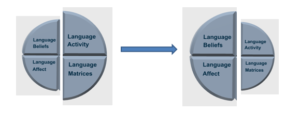Michał Daszkiewicz University of Gdańsk, POLAND; https://orcid.org/0000-0003-2463-393X
DOI: https://doi.org/10.36534/erlj.2021.02.00
Bibliographic citation: (ISSN 2657-9774) Educational Role of Language Journal. Volume 2021-2(6). COVID-19 – LINGUISTIC WELL-BEING (BEFORE DURING, AND AFTER THE PANDEMIC), Introduction, pp. 4-5
Students that do not engage linguistically in classroom activities – for whatever reasons – do not benefit from their education as much as they could. They miss out on numerous developmental opportunities, which frequently occurs at the cost of other students and also teachers themselves, too, since, as a result of such reticent students’ silence, numerous clever ideas and thoughts are lost. The COVID-19 pandemic has been the time during which the aftermath of students’ verbal absence has been experienced on a global scale. It has clearly shown that students lacking in linguistic well-being and remaining consistently speechless throughout their classes and lectures, being hidden behind their deactivated cameras, practically disappear and, subsequently, become likely to fall out of education altogether. In those situations when teachers managed to keep their students linguistically engaged (which tends to imply the latter’s emotional involvement, too), language has served as a kind of glue securing students’ contact with their school settings. However, in all these circumstances where the “glue” in question was missing, students have become passive listeners often preoccupied with other online activities, in the light of which they gradually changed into passive outsiders, taking “advantage” of the fact that they could not be seen. Hence, at the end of the line lack of language and linguistic well-being have meant lack of education altogether.
This heavy reliance of education on language and linguistic well-being has caused teachers to ponder pedagogical phenomena and to reflect on affective and axiological issues much more than they normally do, with the typical focus being on the cognitive and psychomotor aspects of language. From this perspective it can be argued that the pandemic has had its “silver lining” in that it has the potential to mark something of a Copernican turn in how most teachers see the educational role of language and in what facets of language use teachers have come to emphasize in their attempts to maximize their students’ linguistic well-being, which can be presented by the following graph:
As the pandemic has left no-one completely unaffected, under ERL Framework (within which ERL Journal is developed) we have sought our linguistic well-being, too. One of the new ways of keeping its members and other participants mentally sane is productive is the recently introduced (monthly) event called ERL Strokes, the idea of which is to exchange 2-minute “strokes” between different nations, professions, races, or ages, and in this way to foster interpersonal communication and good (but nearly forgotten) old practices of telling stories, jokes, riddles, and sharing interdisciplinary and/or everyday discoveries. The event has served to maintain and boost the participants’ (“strokers’”) linguistic well-being and has been attended by academics and university students, with the two groups sharing the need to communicate and experience new content through all kinds of social occasions. (The term ‘strokes’ has been derived here from Eric Berne’s transactional analysis,, whereby strokes are defined as fundamental units of social action, and used in a wider sense as referring to different types of “verbal pieces” which have something educational and/or entertaining in them and which can be easily be passed from mouth to mouth (and thus t exploit the educational role of language).
Accordingly, ERL Journal’s Volume 6 presents a pool of texts, which jointly constitute a reflection of which conceptual notions have remained in focus throughout the pandemic and how the search for linguistic well-being has proceeded. Specifically, we find papers addressing the emotional facet of online education, pedagogical aspects, preparedness, technological challenges, etc. The reading of papers indicates that the pandemic has come to constitute something of a pedagogical awakening in causing linguists to view reality in pedagogical terms (as well as the other way round). The volume is composed of two parts relating to the linguistic well-being of students and teachers, which is meant to emphasize that fact that issues relating to the eponymous concept pertain to all educational “players”. The papers are complemented by two reports, one written by an academic and one by a student (again – for the sake of balance), both addressing spoken language as the medium particularly meaningful throughout the pandemic. Volume 6 follows Volume 5 (COVID-19 – A Source of Threat or Opportunities for Linguistic Education) in its focus on the pandemic and its educational implications. We do advise our readers to study the content of the preceding volume in order to see the progress of our knowledge and conclusions concerning the impact of pandemic on linguistic education, with Volume 6 offering, as opposed to Volume 5, more questions and viable solutions.
Go to Educational Role of Language Journal – main page
Go to International Association for the Educational Role of Language – main page
